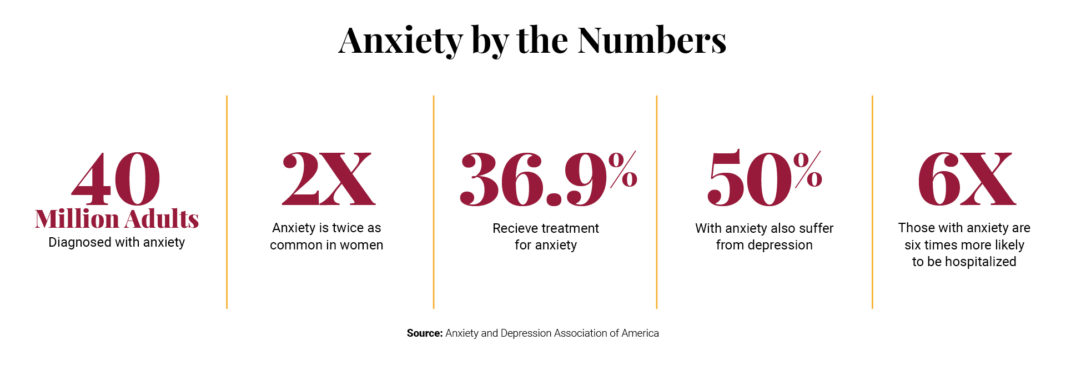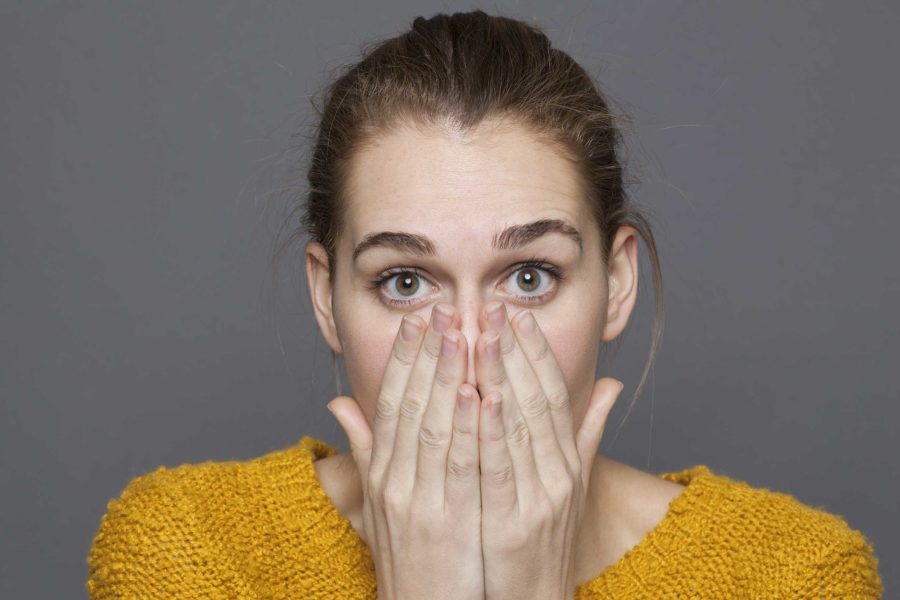Feeling nervous before a big job interview? Having trouble sleeping? Do you go over the day’s events again and again trying to figure out what you did right and what you did wrong?
Sounds a bit like anxiety.
Anxiety is not always a bad thing. It can be a strong motivator and help people meet deadlines and athletes perform better under pressure. It can also be lifesaving and trigger the body’s “fight or flight” response, saving you from an untoward event.
Sometimes, however, the anxiety lingers—even when the source of concern has passed. At times the anxiety appears when there is no visible threat. When it persists for a period of time and begins to impede one’s normal daily activities, in all probability it has moved from an annoying tendency to an anxiety disorder.
The American Psychological Association defines anxiety as “an emotion characterized by feelings of tension, worried thoughts, and physical changes like increased blood pressure.”
 The Numbers
The Numbers
The term “anxiety” is often used loosely. People joke about suffering panic attacks and being OCD, but anxiety is no laughing matter. It is the most common mental health disorder in this country, affecting 40 million adults age 18 and older, according to the National Institute of Mental Health. That’s almost 20 percent of the population.
The volume is a reflection of the number of different kinds of anxiety. The American Psychiatric Association has specified several major types.
- Agoraphobia, or fear of places or situations that might cause panic.
- Generalized anxiety disorder (GAD), which is characterized by persistent and excessive worry about events or activities, including everyday matters. The worry is out of proportion to the circumstances and is difficult to control.
- Panic attacks, or sudden feelings of intense fear that peaks quickly. Typical symptoms are shortness of breath, chest pain, and heart palpitations. People often think they are having a heart attack.
- Social anxiety disorder, which causes fear and avoidance of certain situations due to feelings of embarrassment and concern about being viewed negatively by others.
- Phobias, which are characterized by major anxiety when exposed to specific objects, such as snakes, or situations, such as flying.
- Substance-induced anxiety disorder, or symptoms of panic or anxiety that result from misusing or withdrawing from drugs.
Some disorders once considered anxieties have been recharacterized as anxiety-related by the American Psychiatric Association. Obsessive-compulsive disorder (OCD), post-traumatic stress disorder (PTSD), hoarding, and other disorders are now included in a separate category but are still strongly linked to anxiety.
Risk Factors
It is suspected that anxiety stems from a complex set of risk factors. Trauma, particularly in childhood, or stress due to an illness can precipitate it, as well as genetics or substance abuse. Even other mental health disorders, including depression, can be factors.
The incidence differs by gender and race. Women are more than twice as likely as men to be afflicted in their lifetime, most likely due to differences in brain chemistry, according to the Anxiety and Depression Association of America (ADAA). The theory is that women may be more susceptible to certain hormones, making them twice as vulnerable as men to stress-related disorders.
In addition, certain disorders, such as GAD, social phobia, and panic disorder, affect white women more than African Americans, Asians, and Hispanics.
Women tend to pay a higher price. The Nurses’ Health Study found that women with the highest levels of phobic anxiety were 59 percent more likely to have a heart attack and 31 percent more likely to die from one in comparison to women with lower levels of anxiety. Another study—the Women’s Health Initiative—found that a history of full-blown panic attacks triples the risk of a stroke or coronary event.
Celebrities are not exempt. Gisele Bündchen, supermodel extraordinaire and wife of Patriots quarterback Tom Brady, revealed in her recent book, Lessons: My Path to a Meaningful Life, that she contemplated suicide due to her panic attacks. Jennifer Lawrence, Adele, and Whoopi Goldberg have all claimed to suffer from some form of anxiety.
Symptoms
Although the symptoms may differ by disorder, regardless of the diagnosis, according to the Mayo Clinic, common indicators may include:
- Feeling nervous, restless, or tense
- Having a sense of impending danger, panic, or doom
- Rapid heart rate
- Breathing rapidly (hyperventilation)
- Sweating
- Trembling
- Feeling weak or tired
- Having trouble concentrating or sleeping
- Experiencing gastrointestinal (GI) problems, such as upset stomach
- Having difficulty controlling worry
- Having the urge to avoid things that trigger anxiety
Yet, regardless of the exact diagnosis, there is a common thread that tends to link all forms of anxiety, according to Dr. Todd Farchione, a psychologist affiliated with the Center for Anxiety and Related Disorders at Boston University. “There is a tendency to strong and frequent negative feelings,” he explains. “There is also the tendency to have negative reactions to those feelings.”
Diagnosis
It is not easy to diagnose anxiety. There’s no clear-cut test, and its symptoms can resemble those of many physical disorders. Doctors must rule out several potential causes, including drug withdrawal, asthma, and even menopause.
But, actually, the diagnosis in large part rests with you, since you are the only one who knows exactly how you feel. You may be required to complete self-assessment questionnaires. Some questionnaires, like the Zung Self-Rating Anxiety Scale, helps rate the frequency of anxiety, while the Beck Anxiety Inventory measures its severity. Other tools are geared toward a specific anxiety, such as social phobia and generalized anxiety disorder.
It is possible to have a subclinical form of anxiety, according to Farchione. That means it exists but is not disruptive. “It becomes a disorder when it crosses the line and begins to interfere in one’s life,” he explains. “The bottom line is how much the condition interferes with your life and what measures you take to cope with them.”
He is quick to point out that anxiety is not a disease that’s acquired. “People talk as if it is something they caught,” he says. “That’s not how it works. It’s about behavior.”
A key to the diagnosis, however, is reliance on the DSM-5, an acronym for the Diagnostic and Statistical Manual of Mental Disorders, Edition 5, developed by the American Psychiatric Association. The DSM-5 lists a series of symptoms over a period of time to assist mental health professionals in zeroing in on a diagnosis.
Treatment
The good news is that anxiety is highly treatable. The bad news is that, according to the ADAA, only 40 percent of those afflicted take advantage of available treatment modalities. Although one’s personal goal might be a total cure, the focus of treatment is more on managing anxiety and keeping it under control.
The approach is typically three-pronged. Medication, such as antianxiety and antidepressants, is often paired with talk therapy. But one of the most effective modalities is cognitive behavior therapy (CBT), a short-term form of psychotherapy that focuses on changing unhelpful thoughts, beliefs, and behaviors by developing personal coping strategies.
For example, through CBT, a person with panic disorder may be able to see that the symptoms may be uncomfortable but are not dangerous.
Another modality is acceptance and commitment therapy (ACT), which uses mindfulness to help individuals accept their personal issues and make necessary changes in their behavior.
Increasingly, exercise and alternative treatments, such as deep breathing, yoga, tai chi, and mindfulness, are coupled with other forms of treatment.
The strongest impact of treatment is that people can be taught skills to respond to their emotions. “They can be trained to be their own therapist,” Farchione says.
When not treated, anxiety can result in or exacerbate physical disorders. For instance, there is a link to irritable bowel syndrome, upset stomach, chronic obstructive pulmonary disease and heart disease. It is often the precipitator of headaches and pain.
Prevention
Anxiety can often be prevented. In a recent study published in JAMA Psychiatry, researchers concluded that psychological and/or educational interventions are effective in the prevention of anxiety, and should include school and primary care programs.
Farchione agrees. High-risk individuals, such as those who have already experienced a panic attack or suffer strong negative emotions, can be educated and taught skills to manage their emotions. Mindfulness and meditation have been successful even in four- and five-year-olds, he explains.
One Day at a Time
The ADAA offers tips on how to deal with stress and anxiety.
- Accept that you cannot control everything.
- Do your best instead of aiming for perfection.
- Maintain a positive attitude.
- Learn what triggers your anxiety.
- Limit alcohol and caffeine.
- Get enough sleep.
- Exercise daily.
- Eat well-balanced meals.
- Take deep breaths.
- Take a time out.
- Talk to someone.
Understanding Four of the Most Common Anxiety Disorders
May is #MentalHealthAwareness Month



 7 min read
7 min read





